For each language, an annotated vowel chart illustrates the evolution of the vowel system from Proto-Algonquian. In the vowel charts, solid arrows represent mergers or shifts, dotted arrows represent partial mergers or shifts, greyed-out characters represent Proto-Algonquian phonemes that no longer exist in the language, and circled characters represent new phonemes created by processes other than the shift of an existing phoneme.
Each vowel chart is followed by expository notes; the charts themselves are based on the sources cited in these notes.
Note: I compiled this material and created the vowel charts during my PhD studies in 2011, and there are aspects of the content and presentation that could likely be improved, such as the nonstandard transcription of the Proto-Algonquian round back vowel as <u> rather than <o> and the transcription of the palatal glide as IPA <j> rather than Americanist <y>.
Contents
- Proto-Algonquian
- Central languages: Meskwaki, Miami-Illinois, Shawnee, Menominee, Ojibwe, Cree
- Eastern languages: Proto-Eastern Algonquian, Mi'kmaq, Western Abenaki, Massachusett, Quiripi, Munsee Delaware, Nanticoke
- Plains languages: Cheyenne, Proto-Arapaho-Gros Ventre, Arapaho, Gros Ventre, Nawathinehena, Blackfoot
Proto-Algonquian
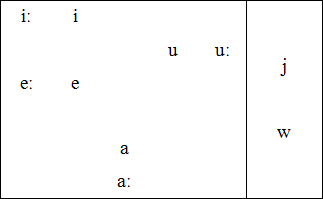
Notes on semivowels:
- Bloomfield (1946: 86) states that the semivowels [j, w] are positional variants of the short vowels /i, u/. However, it is convention to write the semivowels as though they were the separate phonemes /j, w/. According to Bloomfield, "it is likely that in some of the languages the syllabic and nonsyllabic values are no longer mechanically determined."
- Some Late PA semivowel changes from Pentland 1979: 248: *CjV > CV; *tj [tʃj] > tʃ; *θj [ʃj] > ʃ; *sj, *rj > s, r; *jiː > iː
- PA *wu(ː) > *u(ː), except after a vowel (Pentland 1979: 108).
Central languages
Meskwaki
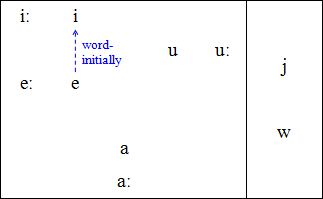
- Semivowel changes: *#we > /u/, *jiː > /iː/, *twi, *rwi > /ti, ni/, *Cji > /Ci/, *CjaC > /CjeːC/, *tʃjaː, *ʃjaː > /tʃaː, ʃaː/, *tʃjeː, *ʃjeː > /tʃeː, ʃeː/ (Bloomfield 1946)
- Phonetically, /e(ː)/ is "very low" (Miner 1979).
Miami-Illinois
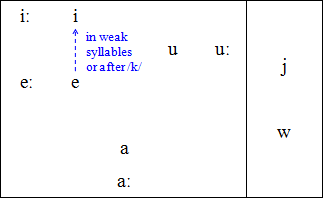
Notes from Costa 2003:
- PA *e > /e/ in strong syllables and word-finally, /i/ in weak syllables, and /i/ in any non-final syllable after /k/.
- PA *eː > iː / k __ (mostly)
- PA *e > i / ʃ __ (in a few words)
- Glides: non-initial *we, *wa > /a/; *we > /a/ in a weak syllable between k __ {p, m}; *uː > aː before /w/ occasionally (dissimilation); *jeː > iː (like Ojibwe and Menominee); *Cjaː preserved; word-final *Cja > /Ca/ but retained in bi-syllabic words; *Cji# > /Ci#/, word-final *eːwa, *iwa, *iːwa > /ia/ in nouns of +3 syllables, or 3-syllable nouns with long vowel in initial syllable; *awe > /uː, aː/; *Vwe > /Vju/, *aje > /eː/
Shawnee

Notes from Pentland 1979:
- *#ke > #ki
- Occasionally, *i > /u/ before /w/.
- Phonetic values: /aː/ [aa, aʰa], /eː/ [ɛæ, ɛʰæ], /iː/ [ii, iʲi], /uː/ [ou, oʷu], /a/ [ɒ], /e/ [ɛ], /i/ [i], /u/ [o]
- *twi > /ti/ (maybe *rwi > /li/); *we > /u/ except after V; *awe > /uː/ (usually); most other *V(ː)we > /Vː/; *Cji > /Ci/; *Cje > /Ce/, maybe *Cja > /Ca/; *CjaC > /CiC/; *Cjiː > /Ciː/; *ʃja, *tʃja > /seː, tʃeː/, elsewhere *ʃjV, *tʃjV > /ʃV, tʃV/; *aje, *aji > /eː/; *#wa > /u/ (except one root); in some suffixes *w+a > /uː/, *j+a > /eː/.
Menominee
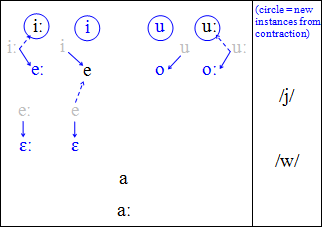
Notes on semivowel changes from Bloomfield 1946:
- *#we > /o/, *Cwi > /Ci/ (but *Cwiw > /Co/, or /Cow/ according to Miner 1979)
- *Cja, *Cwa > /Cia, Cua/; *Cjeː > /Ciː/, *Cweː > /Ciː/ (but *hweː > /hɛː/, Miner 1979); *Cji > /Ci/, *jiː > /iː/
Notes from Miner 1979:
- Glides become phonemic: /wa, ja/ contrast with /ua, ia/.
- *maw > mow
- Apocope: Final short vowels are lost, feeding reduction of final clusters: *mwa > m, *pja > p, *nki > h (cf. *nk clusters), *hkwa > h, *θki > h.
- Length changes: (1) long vowel shortened following a cluster (if not before a cluster); (2) in even-numbered syllable (from beginning of word and each long vowel) V is lengthened if before a cluster, or shortened if not before a cluster; (3) second syllable is lengthened if first syllable contains a short vowel (unless that vowel is followed by ʔ).
Menominee Vowel Shift (Miner 1979):
- (Back vowels followed analogically.)
- PA *e > Men /ɛ/, except (1) word-initially, (2) in initial syllables after C (unless before a Menomini laryngeal, in which case it does lower), and (3) after a Menominee long-vowel syllable (again unless before a Menominee laryngeal).
- PA *i > Men /e/
- PA *eː > Men /ɛː/
- PA *iː > Men /eː/, but not where a Menomini high vowel or post-consonantal glide follows anywhere in the word (unless /ɛ, ɛː/ intervenes, in which case lowering does occur).
- PA *Cwiː, *Cjiː, *Cweː, *Cjeː > /Ciː/ (thus creating many new instances of /iː/ joining those instances of PA *iː that failed to lower).
- PA *Cwi, *Cji > Men /i/ (thus creating a new /i/)
- Presumed sequence: (1) systematic length changes, (2) short vowel lowerings, (3) long vowel lowerings, (4) contractions creating new high vowels. The late occurrence of the long vowel lowerings accords with the fact that the long /iː/-/eː/ alternation is still active and productive (along with its back analogue /uː/-/oː/).
- Synchronically, "failure to lower" has undergone "rule inversion" and can instead be analyzed as raising/height harmony: long /eː, oː/ raise to /iː, uː/ if there is /i u iː uː Cj Cw/ later in the word; blocked by low /ɛ, ɛː/ (Bloomfield 1962).
- Phonetics: /iː/ [iː], /eː/ [eː], /ɛː/ [æː], /i/ [i] before laryngeals, [ɪ] elsewhere; /e/ [ɪ]; /ɛ/ [ɪ] rapid speech, [æ] before laryngeals, [ɛ~ɪ] elsewhere. So it is only in pre-laryngneal position that the short vowels clearly contrast.
Ojibwe
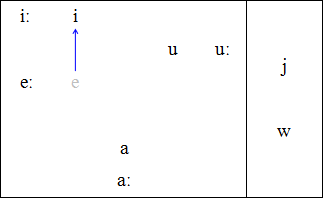
- Semivowel changes: *CjaC > /CiːC/, *Cji > /Ci/, *Cjaː > /Caː/, *ʃjeː > /ʃeː/, elsewhere *Cjeː > /Ciː/, *twi, *rwi > /ti, ni/, *jiː > /iː/, *#we > /u/ (Bloomfield 1946)
- Only Cree and some Ojibwe dialects (among the Central languages) have a mid vowel realization for /eː/; in the other Central languages, /eː/ is phonetically low (Miner 1979).
Cree
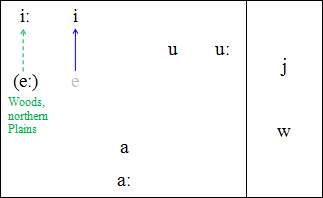
Merger and deletion:
- In Woods and northern Plains, *eː merges with /iː/ (Pentland 1979).
- A short vowel deletes next to another vowel (Pentland 1979: 111).
- Elsewhere, only unstressed short /i/ may delete by syncope (Pentland 1979).
- Only Cree and some Ojibwe dialects (among the Central languages) have a mid vowel realization for /eː/; in the other Central languages, /eː/ is phonetically low (Miner 1979).
Semivowels:
- Bloomfield 1946: *jiː > /iː/, *#we > /u/, *Cjaː > /Caː/, *Cjeː > /Ceː/, *Cji > /Ci/, *Cwi > /Cu/.
- Pentland 1979: *CjV̆ > /CV̆/ with coalescence; *CjVː > /CVː/; after C or #, *wi, *we > /u/ and *ji, *je, *ja > /i/ (except stem-finally); *ewe > /uː/; *ewi > /iː/; sometimes *aje, *aji > /eː/ and *awe, *awi > /uː/.
Eastern languages
Proto-Eastern Algonquian
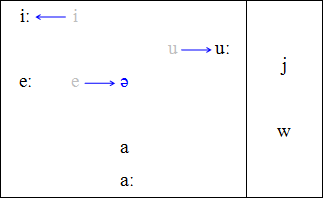
Notes from Goddard 1980:
- The length contrast is lost in the high vowels, and short *e becomes neutral */ə/ (unique to the Eastern languages). Some (Pentland, Aubin, Siebert) have claimed that some extinct Eastern languages maintained the high length contrast, but Goddard does not find these claims persuasive (149).
- High vowels > PEA */ə/ before *w, *j in some cases (also unique to the Eastern languages).
- Word-final vowels are lost, as in many Algonquian languages, but the resulting *kw# retains its /w/. Final vowels are even lost in short-vowel disyllables, a pattern "found elsewhere only in Montagnais" (150).
- Glides: *Cj > */C/, *Cw > */Cw/ generally; sometimes *CweC > */Cu:C/; *w lost after *t, n, θ, r; also, *w lost in the environment C__əB, where B is a labial consonant (*p, *m, *w, *kw); *kenw- 'long' > */kwən-/ (metathesis).
Mi'kmaq
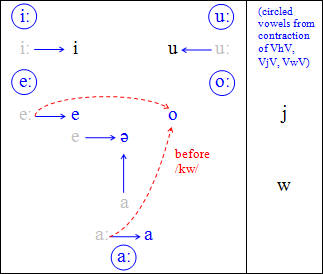
Notes from Hewson 1973 (Newfoundland Mi'kmaq)
- Short vowels: short *e, *a > /ə/ (which regularly deletes in unstressed syllables), short *i, *u remain unchanged.
- PA long vowels are all shortened: long *iː, *uː merge with short /i, u/; long *eː, *aː become short /e, a/ (after original short *e, *a > /ə/).
- The resulting short /i, e, a, u/ were joined by a new short /o/ from the following sources: (1) *a(ː) in contact with /w/ (sometimes), with possible loss of /w/; (2) *eː, *aː, and sometimes *a before /kw/ (more frequent than source #1), (3) analogic spreading of /o/ in paradigms.
- A new series of five long vowels /iː, eː, aː, oː, uː/ (shown in circles in the diagram) was formed from contraction of *VhV, *VjV, and *VwV sequences: /iː/ from *ija, *ija, *iji, *iji; /eː/ from *ehi; /aː/ from *aha, *awaha; /oː/ from *uwi, *awi; /uː/ from *iwa, *iwi, *awa. (And in a few rare cases, PA long vowels have apparently been preserved.)
- Phonetic realization: short /i, e, o, u/ all have tense and lax variants, and /a/ has front and back variants.
Western Abenaki
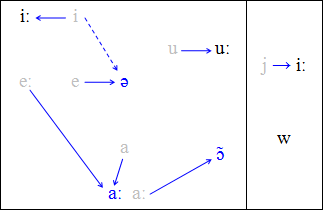
Notes from Warne 1975:
- Length contrasts lost; I align with Goddard's length-marking conventions by writing /iː, uː, aː/ for Warne's /i, u, a/, but /ə/ for her /e/ (which she notes is phonetically [ə]).
- *i > /iː/ usually, but /ə/ before some sonorants.
- *e > /ə/ usually, but /aː/ word-initially; sometimes deleted in word-initial syllables before a cluster; deleted *e can alternate with /iː, aː/; synchronically, unstressed /ə/ can delete.
- *eː > /aː/
- *aː > /ɔ̃/ usually, but /aː/ before a cluster (stages: *aː was shortened to *a before a cluster, then remaining *aː > /ɔ̃/).
- *u > /uː/ usually, but /weː/ word-initially or after /k/.
- *j appears to be consistently vocalized to /iː/.
- Final vowels are deleted, as were resulting final /w, j/ in general, but *w remained after /k, kk/ and *j remained after /p, pp, m/ (and later > /iː/).
- Rounding coalescence: *iw#, *awe, *uwi, *uw, *wu > /uː/.
- Rounding assimilation: in a few instances, *V became /wV/ or /uː/ when the next syllable contains /w/ or /u(ː)/.
- *Cj, *Cw > /C/, except *kw is retained.
- Synchronic rounding process: V́kw → V́wkw (the intervening consonant is always /k/ because /w/ was lost after all other consonants).
Massachusett
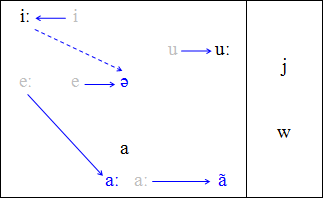
Notes from Goddard 1981:
- Syncope: Unstressed /ə/ can be dropped (apparently optionally); /a/ is subject to syncope before prevocalic /h/.
- Apocope: Word-final loss of vowels and syllables ending in *m, *n, and postvocalic *w, *j.
- Weakening: PEA *iː > /ə/ apparently when in a metrically weak syllable (a syllable preceded by a long-vowel syllable, or preceded by a schwa-syllable which is preceded by a long-vowel syllable). [Palatalization was triggered by weakened *iː but not by strong *iː or *ə (except *əw), so it must have occurred at a time when "weakened iː" was distinct from either /iː/ or /ə/, or only in environments where *iː later merged with ə.]
- "Infection" (progressive palatalization): When weakened *i was followed by /n, t, h, ht/, an [i] quality was added before the V in the following syllable. The resulting [tjV] was different from /tʲ/ from palatalization, because it was never written as "ch".
- Phonetics: Massachusett /aː/ apparently had "a relatively broad phonetic range" (p. 69).
- Glides: PA *VːwV, *VːjV > /VːV/ (usually); PA *Cw generally remains, as does *kw#; from a PEA sound change, *w > Ø / C__əB(C) (where B is a labial: m, p, w, kw; ə can be from PA *e or *i); PA *#we > #ə before a labial or Massachusett /k/, but not before /tʲ/ from *k; PA *Cj > C. \dt
Quiripi
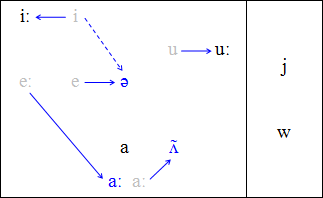
Notes from Rudes 1997:
- In the insular dialect, *i is often weakened to /ə/, as in Massachusett, but no such evidence in the mainland dialect (except before *w).
- Apocope and consequences. Word-final short vowels lost except in monosyllables. Resulting word-final /w, j/ dropped after a long vowel; resulting *Cw# > C (except *kw# retained); resulting *Cj# > C or Cəj; resulting *V̆N# drops (parallel to the loss of coda N in clusters?); resulting *r# > mainland /ʃ/, insular /s/ (parallel to *r in clusters).
- While apocope affects all short vowels, apheresis and syncope generally only affect reflexes of *e, *a. Apheresis: #ə (from PA *e) drops (but not #a). Syncope: *e, *a drop in the following environments (S=sonorant, F=fricative, xF=non-fricative): #S__F, non-initial S__xF, non-initial __CC (the latter is Goddard 1978's "Abenaki Syncope"). Syncope is apparently not conditioned by metrical structure, unlike usual in Algonquian.
- Glides: *Cj > /C/; *Cw > /C/ often, but remains /Cw/ if C is a fricative or *k; *CeSw (where S = sonorant) becomes CweS (metathesis).
Munsee Delaware
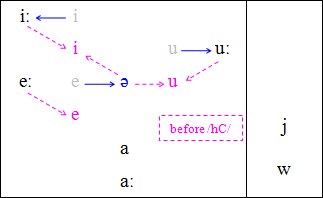
Notes from Goddard 1982:
- Short /i, u, e/ went away in PEA; Munsee developed new short /i, u, e/ from shortening of the long vowels before /hC/ and from raising of /ə/ (and in loanwords).
- PEA */a, ə/ deleted before /h, x/ in a weak syllable; weak /ə/ drops before other voiceless consonants; weak /a/ falls together with /ə/ (or drops) between /h/ and a voiced continuant; some short vowels are inherently strong and never undergo weakening.
- When not deleted, PEA */ə/ > /u/ before /hp, hkw, hw, hm, xkw, xp, xu(ː), nkw/, and between m__x, p__x in Munsee but not Unami; PEA */ə/ > /i/ before other hC.
- In a non-rounding environment, PEA *əx > /ax/.
- If /ə/-deletion leaves a word-initial /w/, it deletes before /p, kw, m, w/ and metathesizes with /k, x, h/.
- Phonetics: /ə/ is mid-central [ə], toward [ɪ] before /j/, [ʊ] before /w/, and [ʌ] after /x/; /a/ is higher-low central [ʌ], lowered to [a] before /hC/; /i, e, u/ are [ɪ, ɛ, ʊ]; /iː, eː, uː/ are [iː, ɛː, oː]; /aː/ is [aː~ɒː] and [ɑː] after labials.
- Glides: *Cj > /C/; *Cw > /C/ except if C is *k, p, m; *w generally retained in all environments in reflexes of *kw (and periodically in *pw, *mw, but they are not found word-finally, unlike /kw/); PEA */wə/ (< PA *we) fell together with PEA */uː/ (< PA *uː) after certain consonants (seemingly *s, ʃ, θ, and maybe *h, t, but not *p, m, k).
Nanticoke
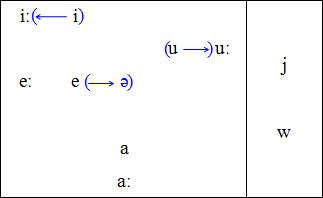
Vowels (Pentland 1979):
- A few words have /aː/ from *eː
- Syncope in unstressed syllables affects /e/ (and less often /i/).
Vowels (Goddard 1980):
- Shifts in parentheses in the vowel chart reflect Goddard's Proto-Eastern Algonquian proposal, in which the high vowels lose the length contrast and short *e shifts to */ə/.
- Pentland argues that a length contrast is needed, but Goddard finds that "claims that PA *iː and *i are kept distinct in some extinct Eastern languages...are not persuasive since they are not based on a demonstration that these protophonemes are kept apart in identical or comparable environments" (149). Although Nanticoke sometimes has shortening of i, "there is no reason to think that PA *i was subject to this change while PA *iː was not" (149).
Semivowels (Pentland 1979):
- *jiː > /iː/; *Cj > /C/; *we > /we/~/u/; *awe, *ewe > /uː/; *eje (< PA *ere, *eθe) and *ije > /iː/.
- In nouns, stem-final *V(ː)n, V(ː)w, V(ː)j drop, but not *V(ː)m, unlike in Southern New England languages.
Plains languages
Cheyenne
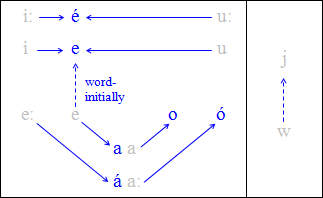
Notes from Goddard 1988:
- Underlying high tone is the reflex of PA vowel length (although complex surface rules operate on underlying tones).
- Backness contrast lost in the high vowels followed by "rotation" of the remaining system: /a/ > /o/ and /e/ > /a/.
- Exceptions involve failure to lower: *e > /e/ word-initially [parallel to word-initial *e > /i/ in Fox], *we > /e/ [reflects late PA *we > *u], and *e, eː > /e, é/ if preceded by Pre-Cheyenne *j.
- Phonetics: Cheyenne /e/ is not much different from [i], and Cheyenne /o/ is not far from reflexes of *a in many languages (so presumably [ɒ, ɔ]).
- Post-consonantal *w merges with *j and the result either becomes /n/ or deletes; post-vocalic *w > /v/ and *j > /t/ (see the consonant chart).
Proto-Arapaho-Gros Ventre
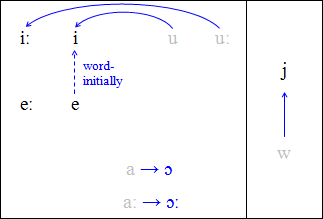
Notes from Goddard 1974:
- Early rules: (1) final vowels were lost (plus a preceding posconsonantal glide), (2) *we > *u (as in the Central languages generally).
- Delabialization: *u(ː) > *i(ː) (including *u < *we) [also *p > *k, *w > *j].
- Rules following delabialization: (1) post-consonantal semivowels lost before *i(ː) (including from *u(ː)); (2) *e merged with *i word-initially, as in several other Algonquian languages; (3) after cluster changes, long vowels shortened before remaining PAGV clusters.
- Phonetics: *a(ː), the low back vowel, is round (as in several Algonquian languages); in modern Arapaho, its reflex is written "o", which Goddard adopts; I will use /ɔ/ to emphasize its low phonological origins.
- Natural classes: /i, e/ later cause fronting of consonants, and /ɔ/ causes backing of consonants (together with new /ɯ/).
- Glides: *w falls together with *j everywhere; the result becomes *j after a consonant and *n after a vowel or word-initially.
Arapaho
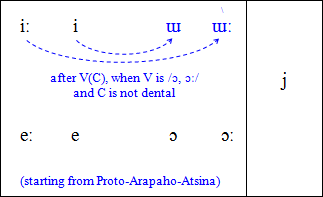
Notes from Goddard 1974:
- PAGV *i, iː > /ɯ, ɯː/ (Goddard's /u, uː/, but described as an "unrounded lower-high back vowel") after a syllable containing *ɔ, ɔː if the intervening consonant (if it exists) is not dental (t, θ, n).
- Backing of *i, iː sometimes continues to spread forwards through the word if the conditions are met, but Goddard does not know the details.
- Vowel contraction has applied to some V-V sequences (many created by the total loss of *k).
- In the modern orthography, long vowels are written as VV, but it "remains to be seen whether or not this is a structurally correct decision" (p. 115).
- PAGV *jeː > /ei/, *je > /i/ (one example), *Cjɔː > /Cjeː/ sometimes, perhaps especially when C is *ʔ.
- There is also some e > ɔ vowel harmony, but it has not been adequately described diachronically or synchronically. Goddard's review (1995) rejects Picard's (1994) proposed analysis as being empirically unfounded.
Gros Ventre
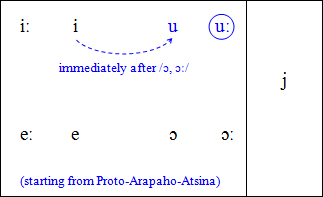
Notes from Goddard 1974:
- PAGV *iː > /u/ (a rounded vowel, unlike in Arapaho) immediately after *ɔ, ɔː (no intervening consonant, unlike in Arapaho).
- In some cases, the resulting *ɔu sequence becomes /uː/.
- Vowel contraction has applied to some V-V sequences (many created by the total loss of *k).
- In the modern orthography, long vowels are written as VV, but it "remains to be seen whether or not this is a structurally correct decision" (p. 115).
Nawathinehena

Vowels (Pentland 1979):
- Phonetic values: /a/ [a, ɑ, ɔ], /e/ [e, ɛ, æ], /aː/ [ɑː], /eː/ [ɛː].
- After /u, uː/ merged with /i, iː/, a new high back vowel was created by this backing rule: i(ː) > u(ː) / a(ː) (C)(C) ___. The rule does not apply if an intervening consonant is dental (*t, *θ, *tʃ, *r, *n, *s; but Nawathinehena /s, ʔs/ from *ʃ, ʃk do not block backing).
- After i-backing, this e-backing rule applied: e(ː) > a(ː) / __ ʔ.
- After e-backing, this vowel harmony rule applied: short /e/ > /a/ if /a(ː)/ is in an adjacent syllable.
Semivowels (Pentland 1979):
- In most environments, *j and *w fell together (parallel to *i and *u), becoming /n/, /i/, or coalescing with a vowel: *Cw/j > /Ci/; *Vw/j > /Vn/ (usually; variation for *w); *weː, jeː > /iː/; some *jV, wV > /i/; *w#, j# > Ø.
- However, *#w remained distinct, becoming /w/ or /m/ depending on the word.
Blackfoot
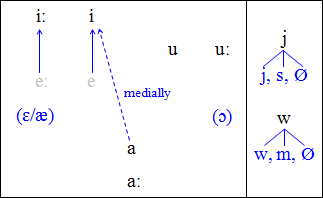
Notes from Berman 2006:
- Word-initial *e merged with *i at an early date (cf. the same merger in other Algonquian languages), and has the same morphophonemic behaviour as PA *i.
- Medial *e and *a merged with *i later. Medial *eː merged with *iː.
- Initial *eː became /niː/ (thus completing the /eː/-/iː/ merger). Initial *aː became /naː/. Berman speculates that this may have gone via an intermediate stage of *jaː (with shift of initial *jaː > /naː/ then parallel to initial *waː > /maː/).
- The sequences /a+i/ and /a+u/ have a monophthongal pronunciation and can be analyzed as the new low-mid vowels /æ, ɔ/ (Frantz 1999) or /ɛ, ɔ/ (Elfner 2005), though this depends on the degree of abstractness in the analysis.
- Coalescence and harmony: *a, e > /u/ before *kw, *Ckw, or a syllable containing u(ː); *we > /u/; *aw > /uw/, *pem > /pum/, *awa, awe > /uː/, *wewiː, weweː > /uː/.
- Reflexes of *w: (1) /m/ in *#waː and *wVw (the second *w > /m/); (2) /j/ in *VwV, if the second vowel is Blackfoot i(ː); (3) /w/ in other *VwV sequences; (4) word-final *kwi falls together with *kji to /ksisi/; (5) elsewhere, *w > Ø after *k, p, m, and word-initially.
- Reflexes of *j: (1) /s/ in *Vja#, Vji#; (2) /j/ in other *VjV; (3) *Cja#, Cji# > /Cisa, Cisi/; (4) elsewhere *Cj > C; (5) *kji# falls together with *kwi to /ksisi/.